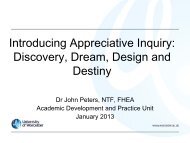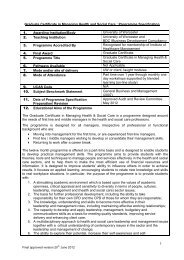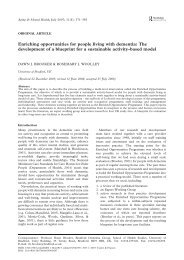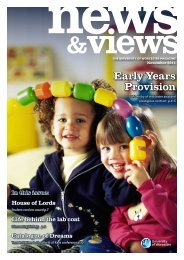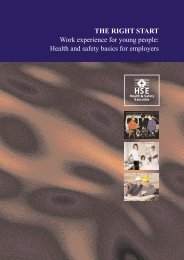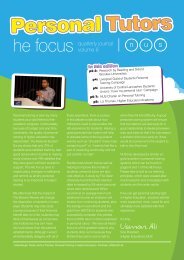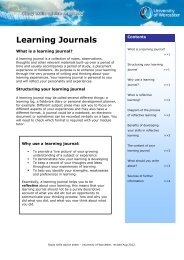The Learning Outcome in Higher Education: Time to think again
The Learning Outcome in Higher Education: Time to think again
The Learning Outcome in Higher Education: Time to think again
Create successful ePaper yourself
Turn your PDF publications into a flip-book with our unique Google optimized e-Paper software.
<strong>The</strong> <strong>Learn<strong>in</strong>g</strong> <strong>Outcome</strong> <strong>in</strong> <strong>Higher</strong> <strong>Education</strong>: <strong>Time</strong> <strong>to</strong> th<strong>in</strong>k aga<strong>in</strong>?Ian ScottUniversity of Worcester(i.scott@worc.ac.uk)As a head of an academic development and practice unit it is with some trepidation that I se<strong>to</strong>ut <strong>to</strong> write this critique of learn<strong>in</strong>g outcomes. For the learn<strong>in</strong>g outcome has become thebed-rock of the <strong>in</strong>fra-structure that determ<strong>in</strong>es quality assurance processes <strong>in</strong> highereducation <strong>in</strong> the UK and elsewhere. In theory, they should be used <strong>to</strong> design courses,determ<strong>in</strong>e appropriate learn<strong>in</strong>g opportunities, measure the level of courses and provide thestandard aga<strong>in</strong>st which students‟ achievement can be measured. In this article I will arguethat the learn<strong>in</strong>g outcome is a false god, <strong>to</strong> whom <strong>to</strong>o much attention is paid and probably bythe wrong people. It is important <strong>to</strong> say, that I am not the first <strong>to</strong> make this case, but do so <strong>in</strong>the hope of rais<strong>in</strong>g a greater level of critical discourse on what has become a hegemonywith<strong>in</strong> higher education.<strong>The</strong> learn<strong>in</strong>g outcome, purpose and orig<strong>in</strong><strong>The</strong> learn<strong>in</strong>g outcome <strong>in</strong> higher education can be seen as a development from outcomebased education with<strong>in</strong> the vocational sec<strong>to</strong>r (e.g. National Vocational Qualifications a.k.a.NVQs). In the vocational sec<strong>to</strong>r learn<strong>in</strong>g outcomes based on competencies are used <strong>to</strong>underp<strong>in</strong> the assessment of job related skills. Once the notion of hav<strong>in</strong>g <strong>to</strong> account forlearn<strong>in</strong>g had been set <strong>in</strong> place the adoption of a system related <strong>to</strong> one already <strong>in</strong>troduced<strong>in</strong><strong>to</strong> parts of the education system was relatively simple and as James (2005) notes, thelearn<strong>in</strong>g outcome is a seductively simple concept, it seems <strong>to</strong> 'do what it says on the can' butdoes it?<strong>The</strong> pedagogic purposes of learn<strong>in</strong>g outcomes are clear, <strong>in</strong> that they are designed <strong>to</strong> give aclear <strong>in</strong>dication of the learn<strong>in</strong>g dest<strong>in</strong>y, that the learn<strong>in</strong>g opportunity provider <strong>in</strong>tends thelearner <strong>to</strong> reach. In do<strong>in</strong>g-so they give power <strong>to</strong> the learner, as armed with knowledge of thedest<strong>in</strong>y the learner can if they wish, chart their own journey <strong>to</strong> this dest<strong>in</strong>ation. It is thispotential for empowerment which allow the proponents of outcomes based education <strong>to</strong>claim that is „student-centred‟ and <strong>in</strong> contrast <strong>to</strong> the previous models where often thedest<strong>in</strong>ation was perceived <strong>to</strong> be hidden, and based largely on what teachers teach.Curriculum models that use learn<strong>in</strong>g outcomes, as logic would dictate, try <strong>to</strong> ensure thatassessments test that students have reached the dest<strong>in</strong>ation described by the learn<strong>in</strong>goutcomes. A further development <strong>to</strong> this is seen <strong>in</strong> the constructive alignment model of Biggs(1996). In this model the <strong>to</strong>tality of the curriculum and assessment is aligned with thelearn<strong>in</strong>g outcomes. Indeed it is Biggs‟s model that underp<strong>in</strong>s much of the UKs qualityassurance system. <strong>The</strong> learn<strong>in</strong>g outcome is used <strong>to</strong> def<strong>in</strong>e the level learn<strong>in</strong>g (Davis 2000and it is worth not<strong>in</strong>g that it also used <strong>to</strong> describe learn<strong>in</strong>g and differ<strong>in</strong>g scales of opportunity,for example at the level of the <strong>in</strong>dividual session, unit or course.To the potential learner, the learn<strong>in</strong>g outcomes describes what will be learnt, <strong>to</strong> the potentialemployer they describe what should have been learnt , <strong>to</strong> the quality agencies they provide asystem for audit and for the funders (if there are still any left) they provide a means <strong>to</strong>account for how the money was spent .A learn<strong>in</strong>g outcome is a description of what a learner will have learnt at the end of a period ofstudy. <strong>Learn<strong>in</strong>g</strong> outcomes <strong>in</strong> theory can encapsulate a wide range of knowledge types skillsand behaviours. We can thus have learn<strong>in</strong>g outcomes that describe: particular skills, such asoperat<strong>in</strong>g a microscope, ways of th<strong>in</strong>k<strong>in</strong>g, such as analyz<strong>in</strong>g, ways of behav<strong>in</strong>g, such asrespect<strong>in</strong>g clients and the possession (de novo) of good old fashioned declarativeknowledge. In some sett<strong>in</strong>g, learn<strong>in</strong>g outcomes are also written <strong>in</strong> relation <strong>to</strong> the values thatWorcester Journal of <strong>Learn<strong>in</strong>g</strong> and Teach<strong>in</strong>g, Issue 5Personal Perspectives Section
will (must) be acquired dur<strong>in</strong>g a period of study. In many education systems the wordlearn<strong>in</strong>g objective is synonymous with the use of 'learn<strong>in</strong>g outcome' <strong>in</strong> UK HE. <strong>The</strong>re ishowever some disagreement with this position (see Adams 2004). <strong>The</strong> term 'learn<strong>in</strong>goutcome' be<strong>in</strong>g seen as identify<strong>in</strong>g what was actually learnt, whilst the learn<strong>in</strong>g objective,what the tu<strong>to</strong>r <strong>in</strong>tends should be learnt. Thus the learn<strong>in</strong>g objective could be seen as be<strong>in</strong>gmore ak<strong>in</strong> <strong>to</strong> the '<strong>in</strong>tended learn<strong>in</strong>g outcome'.<strong>The</strong> orig<strong>in</strong> of the learn<strong>in</strong>g outcome <strong>in</strong> education theory is difficult <strong>to</strong> trace, but may stem fromthe Mastery learn<strong>in</strong>g movements, variously promoted by authors such as Block (1971),Bloom (1981)and Carroll (1963). <strong>The</strong> mastery movement is <strong>in</strong>terest<strong>in</strong>g <strong>in</strong> that it proposedthat the vast majority of learners were capable of achiev<strong>in</strong>g <strong>to</strong> the same extent, but thatlearners would take differ<strong>in</strong>g amount of time and <strong>in</strong>put <strong>to</strong> achieve. With<strong>in</strong> Masteryprogrammes learners must achieve (Master) specific learn<strong>in</strong>g outcomes before be<strong>in</strong>gpermitted <strong>to</strong> proceed <strong>to</strong> the next stage. <strong>The</strong> mastery approach was an overtly behaviouriststrategy, yet <strong>in</strong> recognis<strong>in</strong>g that, given time, most learners can achieve <strong>to</strong> a high standard italso seems <strong>to</strong> have been fundamental <strong>in</strong> the birth of the <strong>Outcome</strong> Based <strong>Education</strong> [OBE]movement <strong>in</strong> the 80s which puts emphasis on the outcomes of learn<strong>in</strong>g processes ratherthan the <strong>in</strong>puts . <strong>Outcome</strong> based education, at least <strong>in</strong> theory, claims <strong>to</strong> be moreconstructionist <strong>in</strong> its approaches.At a more local level it is possible <strong>to</strong> trace the growth of the learn<strong>in</strong>g outcome <strong>in</strong> UK HE <strong>to</strong>the formation of UK wide quality assurance bodies that needed models; aga<strong>in</strong>st which thestandards of degree programmes could be compared and affirmed and the spend<strong>in</strong>g of UKtax payers‟ money justified. Thus we see learn<strong>in</strong>g outcomes feature with<strong>in</strong> the Council forNational Academic Awards (CNAA)'s documentation and then the QAA's; that for manypeople was orig<strong>in</strong>ally seem<strong>in</strong>gly built around the structures of the CNAA. Hussey and Smith(2002) argue that the rise of the learn<strong>in</strong>g outcome is a response <strong>to</strong> the state‟s need forUniversities <strong>to</strong> be seen as more accountable but also represents part of the grow<strong>in</strong>gcommoditisation of education. <strong>Learn<strong>in</strong>g</strong> outcomes be<strong>in</strong>g the 'goods' placed on the table forsale at the new market place. Outwith any pedagogical discussion, Hussey and Smith seethe rise of learn<strong>in</strong>g outcome be<strong>in</strong>g equated with 'loss of trust'. <strong>The</strong> learn<strong>in</strong>g outcome is the<strong>to</strong>ol by which educa<strong>to</strong>rs can be audited and judged.Difficulties (or even problems) with learn<strong>in</strong>g outcomesWhat are they aga<strong>in</strong>?For a seem<strong>in</strong>gly simple concept learn<strong>in</strong>g outcomes seem hard <strong>to</strong> really def<strong>in</strong>e. James andBrown (2005) produced a 3 x 7 matrix of learn<strong>in</strong>g outcome types based around Sfards(1998). Acquisition and Participation metaphors of learn<strong>in</strong>g and seven categories of outcomelocated by the <strong>Learn<strong>in</strong>g</strong> <strong>Outcome</strong>s <strong>The</strong>matic Group of the UK wide Teach<strong>in</strong>g and <strong>Learn<strong>in</strong>g</strong>Research Project (TLRP). <strong>The</strong> categories were:Atta<strong>in</strong>ment - often school curriculum based or measures of basic competence <strong>in</strong>the workplace.Understand<strong>in</strong>g - of ideas, concepts processes.Cognitive and creative - imag<strong>in</strong>ative construction of mean<strong>in</strong>g, arts orperformance.Us<strong>in</strong>g - how <strong>to</strong> practice, manipulate, behave, engage <strong>in</strong> process or systems.<strong>Higher</strong>-order learn<strong>in</strong>g - advanced th<strong>in</strong>k<strong>in</strong>g, reason<strong>in</strong>g and metacognition.Dispositions - attitudes, perceptions, motivations.Membership, <strong>in</strong>clusion, self-worth - aff<strong>in</strong>ity <strong>to</strong>wards or read<strong>in</strong>ess <strong>to</strong> contribute <strong>to</strong>the group where learn<strong>in</strong>g takes place. (James and Brown 2005, 10-11).Worcester Journal of <strong>Learn<strong>in</strong>g</strong> and Teach<strong>in</strong>g, Issue 5Personal Perspectives Section
Us<strong>in</strong>g this matrix James (2005) found that sixteen differ<strong>in</strong>g conceptions of learn<strong>in</strong>goutcomes could be produced, one for each site of their study. This difference probably stemsfrom difference <strong>in</strong> conceptions of learn<strong>in</strong>g, the relative importance placed on different formsof learn<strong>in</strong>g and an understand<strong>in</strong>g of what that learn<strong>in</strong>g is for and how it is achieved. In otherwords, learn<strong>in</strong>g outcomes are socially constructed by a varied community and thus,common understand<strong>in</strong>g across the entire sec<strong>to</strong>r (FE) that James studied, was absent, this,despite the fact that learn<strong>in</strong>g outcomes essentially(at least <strong>in</strong> theory) dictate what isimportant <strong>to</strong> 'know' and what it is not (James 2004). This latter po<strong>in</strong>t is important becausestudents often give more significance <strong>to</strong> the personal and social dimensions of change tha<strong>to</strong>ccur for them at University than the learn<strong>in</strong>g ga<strong>in</strong>ed through the formal curriculum. Yet thislearn<strong>in</strong>g, because it is not formally given a 'learn<strong>in</strong>g outcome' escapes the learn<strong>in</strong>gaccountants (TLRP 2008).Words alone fail me and our studentsTo illustrate this issue I will take a relatively simple learn<strong>in</strong>g outcome from a hypotheticalcompetency based carpentry course.After the period of learn<strong>in</strong>g the student will be able <strong>to</strong>: bang a nail <strong>in</strong><strong>to</strong> a plank of woodwithout splitt<strong>in</strong>g the wood.At first glance, this seems like a straightforward learn<strong>in</strong>g outcome, but the carpenter mightwell ask, “which type of wood" or "which type of nail”. So I would need <strong>to</strong> moderate theoutcome so that it might become;After the period of learn<strong>in</strong>g the student will be able <strong>to</strong>: bang the appropriate nail <strong>in</strong><strong>to</strong> aplank from a range of commonly used timbers without splitt<strong>in</strong>g the wood.Of course, after speak<strong>in</strong>g aga<strong>in</strong> with the carpenter, she th<strong>in</strong>ks that accuracy is also importantand of course safety. So, after embark<strong>in</strong>g on def<strong>in</strong><strong>in</strong>g the seem<strong>in</strong>g obvious, I am confrontedby the carpenter from the ship yard, who notes that what is a common wood for some is notcommon for him, how was he meant <strong>to</strong> know what I meant or what his student was meant <strong>to</strong>learn. <strong>The</strong> only defence from the carpenter's demands is <strong>to</strong> either write with more and morespecificity or greater generality. <strong>The</strong> problem with the former be<strong>in</strong>g that <strong>in</strong>creased specificitystarts <strong>to</strong> exclude many practices and as Yorke (2003 p210) suggest leads <strong>to</strong>;" the entangl<strong>in</strong>g and disorientat<strong>in</strong>g jungle of details as was experienced by those faced withthe system of NVQs developed under the aegis of the National Council for VocationalQualifications <strong>in</strong> the UK....”On the other hand, writ<strong>in</strong>g very broad and general learn<strong>in</strong>g outcomes means that either noone is clear what the learn<strong>in</strong>g outcome is about or that you can work it out only if you havesufficient prior knowledge and understand<strong>in</strong>g of the subject <strong>in</strong> question and its context. Thisargument, as demonstrated <strong>in</strong> the example above, also applies when we try <strong>to</strong> use specificand precise language. Hussey and Smith (2002 p225) suggests that <strong>in</strong> order <strong>to</strong> explicate aphenomena a learn<strong>in</strong>g outcome must "parasitise" that which they are meant <strong>to</strong> beexpla<strong>in</strong><strong>in</strong>g. <strong>The</strong> issue of context is also a significant confound<strong>in</strong>g issue. This is because themean<strong>in</strong>g of particular words varies depend<strong>in</strong>g on the academic subject <strong>in</strong> question. A wordsuch as analyse means someth<strong>in</strong>g quite different depend<strong>in</strong>g on whether your subject isEnglish, Chemistry or Biology. What this means of course, is that the only way the mean<strong>in</strong>gof a learn<strong>in</strong>g outcome is unders<strong>to</strong>od is through „experienc<strong>in</strong>g the subject‟ and the real utilityof a learn<strong>in</strong>g outcome <strong>to</strong> the „outsider‟ albeit a prospective student, employer or externalscrut<strong>in</strong>isers is very limited. Ow<strong>in</strong>g <strong>to</strong> these issues of language and context, even whenlearn<strong>in</strong>g outcomes use very precise terms they are <strong>in</strong> fact always quite hazy (Knight andYorke, 2003) their exact mean<strong>in</strong>g only comes <strong>in</strong><strong>to</strong> be<strong>in</strong>g when tu<strong>to</strong>rs and students <strong>in</strong>terpretthem, although we have <strong>to</strong> hope they <strong>in</strong>terpret them <strong>in</strong> the same way.Worcester Journal of <strong>Learn<strong>in</strong>g</strong> and Teach<strong>in</strong>g, Issue 5Personal Perspectives Section
easonable at home <strong>in</strong> module outl<strong>in</strong>es of many universities across the United K<strong>in</strong>gdom.Here aga<strong>in</strong>, we have met the issue of language <strong>in</strong> context, if you were a secondary schoolscience teacher, you would have a good idea what level of learn<strong>in</strong>g the first outcome wasreferr<strong>in</strong>g <strong>to</strong> but the same language placed <strong>in</strong> the context of HE may mean (we hope) adifferent level al<strong>to</strong>gether. So it would seem that <strong>in</strong> terms of level, learn<strong>in</strong>g outcomes aga<strong>in</strong>only have mean<strong>in</strong>g <strong>in</strong> the context of their subject and <strong>in</strong> the context of the level at which theyare applied. Thus suggest<strong>in</strong>g that their utility is only <strong>to</strong> those who understand these contextsand without knowledge of this context the notion of levell<strong>in</strong>g us<strong>in</strong>g learn<strong>in</strong>g outcomesbecomes mean<strong>in</strong>gless.Similar problems can also occur when learn<strong>in</strong>g outcomes are <strong>to</strong>o closely l<strong>in</strong>ked <strong>to</strong>assessments. If we accept that <strong>to</strong> understand what is meant by the language and context ofa learn<strong>in</strong>g outcome then a detailed knowledge of the subject and context of that learn<strong>in</strong>goutcome is required then, whilst this may be possible for some students, many modularschemes require students <strong>to</strong> ga<strong>in</strong> mean<strong>in</strong>g from these outcomes before they have beenapprenticed <strong>in</strong><strong>to</strong> their areas of study. This leads tu<strong>to</strong>rs <strong>to</strong> give more and more detailed<strong>in</strong>formation about what is „required‟ <strong>to</strong> pass the assessment which, <strong>in</strong> turn, results <strong>in</strong> „surface‟engagement (sensu Mar<strong>to</strong>n and Säljö, 1976) with the learn<strong>in</strong>g that the assessment was<strong>in</strong>tended <strong>to</strong> help students achieve (Gibbs and Simpson 2004). Gibbs and Simpson (2004)suggest that for students <strong>to</strong> succeed on assessments they must <strong>in</strong>deed <strong>in</strong>ternalise what isrequired but the way that this is best achieved is through rehearsal and feedback onperformance.Perhaps a more complex problem <strong>to</strong> overcome is that which relates <strong>to</strong> whether or not thelearn<strong>in</strong>g outcomes are those that must be achieved and therefore assessed or whether theyare <strong>in</strong>tended learn<strong>in</strong>g outcomes only. If they are fixed learn<strong>in</strong>g outcomes then if a studentassesses as a genius aga<strong>in</strong>st 80% of a module‟s learn<strong>in</strong>g outcomes but does not achievethe others then they must be given a fail overall. Given the <strong>in</strong>tractability of def<strong>in</strong><strong>in</strong>g learn<strong>in</strong>goutcomes (described above) we need <strong>to</strong> ask if such a position is justifiable. A related issuewas described by Biggs (1996) who discussed the importance of assess<strong>in</strong>g un<strong>in</strong>tendedlearn<strong>in</strong>g outcomes as well as the <strong>in</strong>tended learn<strong>in</strong>g outcomes with the follow<strong>in</strong>g metaphor:Teacher: How many diamonds have you got?Student: I don’t have any diamondsTeacher: <strong>The</strong>n you fail!Student: But you didn’t ask me about my jade!Conclusion: Learners amass treasure not just diamond. (Biggs J. 1996 p352 ).From this metaphor it is possible <strong>to</strong> see how the use of learn<strong>in</strong>g outcomes as a basis forassessment can drive us <strong>to</strong> adopt processes that ignore substantive learn<strong>in</strong>g simplybecause our system makes it not liable <strong>to</strong> assessment. Furthermore, once students realisethat only the learn<strong>in</strong>g described by learn<strong>in</strong>g outcomes is <strong>to</strong> be assessed they focus only ondemonstrat<strong>in</strong>g this learn<strong>in</strong>g (although not necessarily achiev<strong>in</strong>g that learn<strong>in</strong>g (see Gibbs andSimpson 2004-5)). Thus rather than encourag<strong>in</strong>g learn<strong>in</strong>g learn<strong>in</strong>g outcomes can end upsubvert<strong>in</strong>g it.<strong>The</strong> way forwardIt is obviously a good idea for students and tu<strong>to</strong>rs <strong>to</strong> have a common understand<strong>in</strong>g of whatthey are try<strong>in</strong>g <strong>to</strong> achieve and hav<strong>in</strong>g learn<strong>in</strong>g outcomes seems a reasonable start<strong>in</strong>g po<strong>in</strong>tas a means <strong>to</strong> achieve this. <strong>Learn<strong>in</strong>g</strong> outcomes also form a good departure po<strong>in</strong>t whenconsider<strong>in</strong>g how <strong>to</strong> formulate learn<strong>in</strong>g opportunity and develop resources. As soon, however,as we start <strong>to</strong> believe that learn<strong>in</strong>g can be precisely def<strong>in</strong>ed and articulated and that thesearticulations should form the basis of the design, development, def<strong>in</strong>ition and assessment ofcourses then we are divorc<strong>in</strong>g ourselves from the process and outcomes of real learn<strong>in</strong>g. Itis this lack of authenticity that Hussey and Smith (2002) claim lead <strong>to</strong> the widespreadWorcester Journal of <strong>Learn<strong>in</strong>g</strong> and Teach<strong>in</strong>g, Issue 5Personal Perspectives Section
derision <strong>in</strong> which the „learn<strong>in</strong>g outcomes culture‟ is held by many academics. Just asstudents do with assessments, academics have learnt <strong>to</strong> mirror what is required by thequality process and revel <strong>in</strong> their conspiracy at the cappucc<strong>in</strong>o bar.We should not thereforeseek <strong>to</strong> measure quality and def<strong>in</strong>e our programmes by such a simplistic and ill def<strong>in</strong>econcept as the learn<strong>in</strong>g outcome, but seek <strong>to</strong> encapsulate the richness of the learn<strong>in</strong>gexperience that are provided by the university community..<strong>Learn<strong>in</strong>g</strong> outcomes, at best, should be seen as an <strong>in</strong>tended broad notion of where thelearners and tu<strong>to</strong>r th<strong>in</strong>k they may be go<strong>in</strong>g. As if they were a proposed dest<strong>in</strong>ation for anexplora<strong>to</strong>ry sail<strong>in</strong>g trip. And just with such a trip, although the skipper may have some idea ofhow <strong>to</strong> get <strong>to</strong> the <strong>in</strong>tended dest<strong>in</strong>ation, the actual route and eventual dest<strong>in</strong>ation will dependon many fac<strong>to</strong>rs, such as the weather and abilities of the crew.Much of the critique above stems from the argument that learn<strong>in</strong>g outcomes only havemean<strong>in</strong>g if their context and the prior knowledge they are built on is unders<strong>to</strong>od. But how dostudents know this context and knowledge? In reality students learn what is required bybecom<strong>in</strong>g part of the communities <strong>in</strong> which they are learn<strong>in</strong>g. This is the case whether thelearn<strong>in</strong>g concerns becom<strong>in</strong>g a plumber or becom<strong>in</strong>g a philosopher. Students learn the waysand language of their discipl<strong>in</strong>es by participation and be<strong>in</strong>g part of the discipl<strong>in</strong>e, vocation orprofession. This picture is <strong>in</strong> many ways similar <strong>to</strong> the idea of „communities of practice‟ asdescribed by Lave and Wenger (1991); with new students stand<strong>in</strong>g on the edges of thecommunity and eventually becom<strong>in</strong>g „experts‟ themselves. Indeed this process is often seen<strong>in</strong> metaphor at degree ceremonies, where new Graduates „full‟ membership of academiccommunity is acknowledge by grant<strong>in</strong>g them permission <strong>to</strong> jo<strong>in</strong> the exit procession.Follow<strong>in</strong>g on this l<strong>in</strong>e of th<strong>in</strong>k<strong>in</strong>g, learn<strong>in</strong>g outcomes and the associated documentation(Programme specifications and the ilk) could be seen as <strong>to</strong>ols that might facilitate a student‟sjourney <strong>in</strong><strong>to</strong> a community. Indeed, Wenger (1998) further elaborated on the community ofpractice model, dist<strong>in</strong>guish<strong>in</strong>g between the practice elements and those that are structural;programme documentation could be seen as part of this „structural‟ aspect of the community.It is important <strong>to</strong> note however that the understand<strong>in</strong>g of the ways of the community onlyemerge through active participation, thus without rehearsal and engagement a student willnever be able <strong>to</strong> discover the context and the true underp<strong>in</strong>n<strong>in</strong>g language of the community‟sdocumentation.<strong>Learn<strong>in</strong>g</strong> outcomes orig<strong>in</strong>ated <strong>in</strong> the movement for more student centred learn<strong>in</strong>g. Return<strong>in</strong>g<strong>to</strong> this aspect of student centeredness may <strong>in</strong>dicate how we can really use this concept. Ifstudents were „permitted‟ <strong>to</strong> design and formulate their own <strong>in</strong>tended learn<strong>in</strong>g outcomes <strong>in</strong>their own language it would alleviate the problems associated with context and languagedescribed above. Such an idea is at the heart of the Personal Development Movement andthe thrust beh<strong>in</strong>d many work based learn<strong>in</strong>g programmes (Boud and Solomon 2001).Add<strong>in</strong>g credence <strong>to</strong> this position it is <strong>in</strong>terest<strong>in</strong>g <strong>to</strong> note that several work based learn<strong>in</strong>gproviders are work<strong>in</strong>g on systems <strong>to</strong> facilitate translation between work based learn<strong>in</strong>goutcomes and academic learn<strong>in</strong>g outcomes (see for example the co-gent project athttp://www.pebblelearn<strong>in</strong>g.co.uk/cogent/).<strong>The</strong> challenge for <strong>in</strong>stitutions of education, if we really do want <strong>to</strong> embrace student centredlearn<strong>in</strong>g, is <strong>to</strong> produce system and practice that allow students <strong>to</strong> negotiate and def<strong>in</strong>e theirown learn<strong>in</strong>g outcomes, <strong>to</strong> be able <strong>to</strong> revisit and adapt these outcomes and at the end oftheir learn<strong>in</strong>g journey at university <strong>to</strong> able <strong>to</strong> say where they have been and what they havelearnt.Worcester Journal of <strong>Learn<strong>in</strong>g</strong> and Teach<strong>in</strong>g, Issue 5Personal Perspectives Section
Lave J. and Wenger, E (1991) Situated <strong>Learn<strong>in</strong>g</strong>: legitimate peripheral participationCambridge: Cambridge University Press.Mar<strong>to</strong>n, F. and Säljö (1976) "On Qualitative Differences <strong>in</strong> <strong>Learn<strong>in</strong>g</strong> — 2: <strong>Outcome</strong> as afunction of the learner's conception of the task" British Journal of <strong>Education</strong>al.Psychology. 46, 115-27.Megg<strong>in</strong>son, D. (1996) Planned and Emergent <strong>Learn<strong>in</strong>g</strong>. Management <strong>Learn<strong>in</strong>g</strong> 27(4) 411-28.Sfard, A. (1998) On two metaphors for learn<strong>in</strong>g and the dangers of choos<strong>in</strong>g just one.<strong>Education</strong> Researcher, 27 (2) 4-13.TLRP (2008) What is learned at university? <strong>The</strong> social and organisational mediation ofuniversity learn<strong>in</strong>g. TLRP Research Brief Number 32.[www.tlrp.org/pub/documents/Brennan%20RB%2032%20FINAL.pdf ].Wenger, N. (1998) Communities of Practice; learn<strong>in</strong>g, mean<strong>in</strong>g and identity Cambridge;Cambridge University Press.http://nationalstrategies.standards.dcsf.gov.uk [accesses 29/31/11]Worcester Journal of <strong>Learn<strong>in</strong>g</strong> and Teach<strong>in</strong>g, Issue 5Personal Perspectives Section



